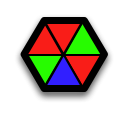I have decided to go with the simplest solution regarding the object of dream combat: the goal is to obtain a minimum number of auras. The players all begin with a random collection of X auras, and a player must obtain Y auras in order to win. The question is, what are the values of X and Y?
I’ll begin with Y. There are three obvious possibilities: 6, 7, and 8. 6 because that would fit nicely into a hexagon as triangles:

7 auras would be used to build a flower:
8 auras would fully utilize the number system used in SympolTalk:
However, I could alter the SympolTalk numbers to represent a count of six:

This has the advantage of greater syntony with the deeper ideas of the game. Another possibility arises from the fact that numbers only apply to auras; we could therefore use color-specific answers. Instead of saying:

We would simply say:

No, probably not. But I like the idea of the hexagonal numbering system that I shall replace the old octagonal system with this. That in turn means that the value of Y is six. The value of X is easily guessed from there: five is too many, as a single victory wins the game. The same thing applies to four: with two dream-combats per night, there’s an 11% chance that, by pure luck, somebody could win in the first turn. With seven players, the probability of anybody winning on the first turn is 56%. That seems to nail X at three. But that creates a new problem: it is possible to overshoot, winning seven auras. It’s unlikely, of course, but possible. I think I can live with that. I can further delay victory by increasing the probability of people knowing your aura counts as they rise. Perhaps losers of dream combat should be more willing to spill the beans about the person who defeated them. Yes, I like that.
